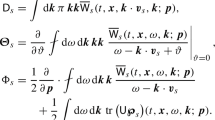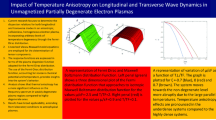Abstract
In an isotropic background comprised of free charges, the transverse and longitudinal modes of the photon acquire large corrections to their dispersion relations, described by the in-medium photon self-energy. Previous work has developed simple approximations that describe the propagation of on-shell photons in plasmas of varying temperatures and densities. However, off-shell excitations can also receive large medium-induced corrections, and the on-shell approximations have often been used in an effort to capture these effects. In this work we show that the off-shell self-energy can be qualitatively very different than the on-shell case. We develop analytic approximations that are accurate everywhere in phase space, especially in classical and degenerate plasmas. From these, we recover the on-shell expressions in the appropriate limit. Our expressions also reproduce the well-known Lindhard response function from solid-state physics for the longitudinal mode.
Article PDF
Similar content being viewed by others
Explore related subjects
Discover the latest articles and news from researchers in related subjects, suggested using machine learning.Avoid common mistakes on your manuscript.
References
E. Braaten and D. Segel, Neutrino energy loss from the plasma process at all temperatures and densities, Phys. Rev. D 48 (1993) 1478 [hep-ph/9302213] [INSPIRE].
G.G. Raffelt, Stars as laboratories for fundamental physics: The astrophysics of neutrinos, axions, and other weakly interacting particles, University of Chicago Press (1996).
J.D. Jackson, Classical electrodynamics, 2nd ed., Wiley, New York (1975).
E. Braaten, Neutrino emissivity of an ultrarelativistic plasma from positron and plasmino annihilation, Astrophys. J. 392 (1992) 70.
D.G. Yakovlev, A.D. Kaminker, O.Y. Gnedin and P. Haensel, Neutrino emission from neutron stars, Phys. Rept. 354 (2001) 1 [astro-ph/0012122] [INSPIRE].
G.G. Raffelt, Limits on neutrino electromagnetic properties: an update, Phys. Rept. 320 (1999) 319 [INSPIRE].
G.G. Raffelt, Plasmon Decay Into Low Mass Bosons in Stars, Phys. Rev. D 37 (1988) 1356 [INSPIRE].
H.K. Dreiner, J.-F. Fortin, J. Isern and L. Ubaldi, White Dwarfs constrain Dark Forces, Phys. Rev. D 88 (2013) 043517 [arXiv:1303.7232] [INSPIRE].
H. Vogel and J. Redondo, Dark Radiation constraints on minicharged particles in models with a hidden photon, JCAP 02 (2014) 029 [arXiv:1311.2600] [INSPIRE].
C. Dvorkin, T. Lin and K. Schutz, Making dark matter out of light: freeze-in from plasma effects, Phys. Rev. D 99 (2019) 115009 [Erratum ibid. 105 (2022) 119901] [arXiv:1902.08623] [INSPIRE].
A. Fung et al., New bounds on light millicharged particles from the tip of the red-giant branch, Phys. Rev. D 109 (2024) 083011 [arXiv:2309.06465] [INSPIRE].
J.I. Kapusta and C. Gale, Finite-temperature field theory: principles and applications, Cambridge University Press (2011) [https://doi.org/10.1017/CBO9780511535130] [INSPIRE].
H.A. Weldon, Simple Rules for Discontinuities in Finite Temperature Field Theory, Phys. Rev. D 28 (1983) 2007 [INSPIRE].
A. Das, Finite Temperature Field Theory, World Scientific, New York (1997).
M. Laine and A. Vuorinen, Basics of Thermal Field Theory, Lect. Notes Phys. 925 (2016) [INSPIRE].
M.L. Bellac, Thermal Field Theory, Cambridge University Press (2011) [https://doi.org/10.1017/CBO9780511721700] [INSPIRE].
G.G. Raffelt, Stars as laboratories for fundamental physics: The astrophysics of neutrinos, axions, and other weakly interacting particles, final manuscript with some errata fixed (2023), https://wwwth.mpp.mpg.de/members/raffelt/mypapers/Stars.pdf.
G.G. Raffelt and L. Stodolsky, Mixing of the Photon with Low Mass Particles, Phys. Rev. D 37 (1988) 1237 [INSPIRE].
E. Fischbach et al., New geomagnetic limits on the photon mass and on long range forces coexisting with electromagnetism, Phys. Rev. Lett. 73 (1994) 514 [INSPIRE].
K.A. Hochmuth and G. Sigl, Effects of Axion-Photon Mixing on Gamma-Ray Spectra from Magnetized Astrophysical Sources, Phys. Rev. D 76 (2007) 123011 [arXiv:0708.1144] [INSPIRE].
P. Arias et al., WISPy Cold Dark Matter, JCAP 06 (2012) 013 [arXiv:1201.5902] [INSPIRE].
H. An, M. Pospelov and J. Pradler, New stellar constraints on dark photons, Phys. Lett. B 725 (2013) 190 [arXiv:1302.3884] [INSPIRE].
J. Redondo and G. Raffelt, Solar constraints on hidden photons re-visited, JCAP 08 (2013) 034 [arXiv:1305.2920] [INSPIRE].
E. Hardy and R. Lasenby, Stellar cooling bounds on new light particles: plasma mixing effects, JHEP 02 (2017) 033 [arXiv:1611.05852] [INSPIRE].
J.H. Chang, R. Essig and S.D. McDermott, Revisiting Supernova 1987A Constraints on Dark Photons, JHEP 01 (2017) 107 [arXiv:1611.03864] [INSPIRE].
S.D. McDermott and S.J. Witte, Cosmological evolution of light dark photon dark matter, Phys. Rev. D 101 (2020) 063030 [arXiv:1911.05086] [INSPIRE].
A. Mirizzi, J. Redondo and G. Sigl, Microwave Background Constraints on Mixing of Photons with Hidden Photons, JCAP 03 (2009) 026 [arXiv:0901.0014] [INSPIRE].
A. Mirizzi, J. Redondo and G. Sigl, Constraining resonant photon-axion conversions in the Early Universe, JCAP 08 (2009) 001 [arXiv:0905.4865] [INSPIRE].
A. Caputo, H. Liu, S. Mishra-Sharma and J.T. Ruderman, Dark Photon Oscillations in Our Inhomogeneous Universe, Phys. Rev. Lett. 125 (2020) 221303 [arXiv:2002.05165] [INSPIRE].
S.-P. Li and X.-J. Xu, Production rates of dark photons and Z’ in the Sun and stellar cooling bounds, JCAP 09 (2023) 009 [arXiv:2304.12907] [INSPIRE].
A.A. Garcia et al., Effective photon mass and (dark) photon conversion in the inhomogeneous Universe, JCAP 10 (2020) 011 [arXiv:2003.10465] [INSPIRE].
M. Lawson et al., Tunable axion plasma haloscopes, Phys. Rev. Lett. 123 (2019) 141802 [arXiv:1904.11872] [INSPIRE].
G.B. Gelmini, A.J. Millar, V. Takhistov and E. Vitagliano, Probing dark photons with plasma haloscopes, Phys. Rev. D 102 (2020) 043003 [arXiv:2006.06836] [INSPIRE].
N. Brahma, A. Berlin and K. Schutz, Photon-dark photon conversion with multiple level crossings, Phys. Rev. D 108 (2023) 095045 [arXiv:2308.08586] [INSPIRE].
J. Lindhard, On the properties of a gas of charged particles, Dan. Mat. Fys. Medd. 28 (1954).
M. Dressel and G. Grüner, Electrodynamics of Solids: Optical Properties of Electrons in Matter, Cambridge University Press (2002) [https://doi.org/10.1017/cbo9780511606168].
S. Knapen, J. Kozaczuk and T. Lin, python package for dark matter scattering in dielectric targets, Phys. Rev. D 105 (2022) 015014 [arXiv:2104.12786] [INSPIRE].
S. Knapen, J. Kozaczuk and T. Lin, Dark matter-electron scattering in dielectrics, Phys. Rev. D 104 (2021) 015031 [arXiv:2101.08275] [INSPIRE].
Y. Hochberg et al., Determining Dark-Matter–Electron Scattering Rates from the Dielectric Function, Phys. Rev. Lett. 127 (2021) 151802 [arXiv:2101.08263] [INSPIRE].
L.D. Landau and I. Pomeranchuk, Electron cascade process at very high-energies, Dokl. Akad. Nauk Ser. Fiz. 92 (1953) 735 [INSPIRE].
L.D. Landau and I. Pomeranchuk, Limits of applicability of the theory of bremsstrahlung electrons and pair production at high-energies, Dokl. Akad. Nauk Ser. Fiz. 92 (1953) 535 [INSPIRE].
A.B. Migdal, Bremsstrahlung and pair production in condensed media at high-energies, Phys. Rev. 103 (1956) 1811 [INSPIRE].
C.R. Harris et al., Array programming with NumPy, Nature 585 (2020) 357 [arXiv:2006.10256] [INSPIRE].
P. Virtanen et al., SciPy 1.0 — Fundamental Algorithms for Scientific Computing in Python, Nature Meth. 17 (2020) 261 [arXiv:1907.10121] [INSPIRE].
J.D. Hunter, Matplotlib: a 2D Graphics Environment, Comput. Sci. Eng. 9 (2007) 90 [INSPIRE].
S. Wolfram, The Mathematica book, Wolfram Research, Inc. (1996).
Acknowledgments
It is a pleasure to thank Nirmalya Brahma, Simon Caron-Huot, Charles Gale, Saniya Heeba, and Oscar Hernández for useful conversations pertaining to this work and comments on the manuscript. We especially thank Tongyan Lin for pointing out the connection between our work and the Lindhard response function. HS was supported in part by a Master research scholarship from the Fonds de recherche du Québec – Nature et technologies (FRQNT). KS and HS acknowledge support from the Programme Établissement de la relève professorale from the FRQNT, from a Natural Sciences and Engineering Research Council of Canada Subatomic Physics Discovery Grant, and from the Canada Research Chairs program. KS thanks the Kavli Institute for the Physics and Mathematics of the Universe and the Kavli Institute for Theoretical Physics (supported by grant NSF PHY-2309135) for their hospitality in the late stages of the completion of this work. This analysis made use of Numpy [43], Scipy [44], Matplotlib [45], and Mathematica [46].
Author information
Authors and Affiliations
Corresponding author
Additional information
Publisher’s Note
Springer Nature remains neutral with regard to jurisdictional claims in published maps and institutional affiliations.
ArXiv ePrint: 2405.18466
Rights and permissions
Open Access . This article is distributed under the terms of the Creative Commons Attribution License (CC-BY 4.0), which permits any use, distribution and reproduction in any medium, provided the original author(s) and source are credited.
About this article
Cite this article
Schérer, H., Schutz, K. Photon self-energy at all temperatures and densities in all of phase space. J. High Energ. Phys. 2024, 139 (2024). https://doi.org/10.1007/JHEP11(2024)139
Received:
Revised:
Accepted:
Published:
DOI: https://doi.org/10.1007/JHEP11(2024)139




